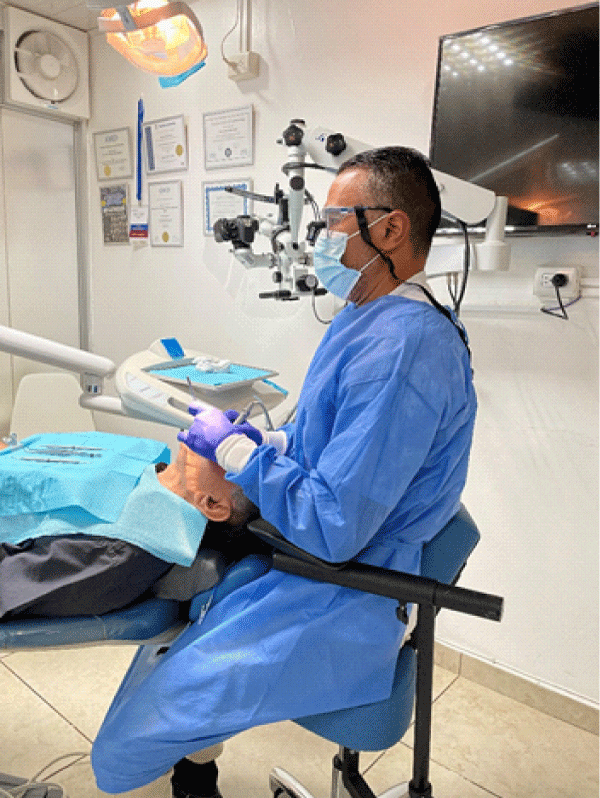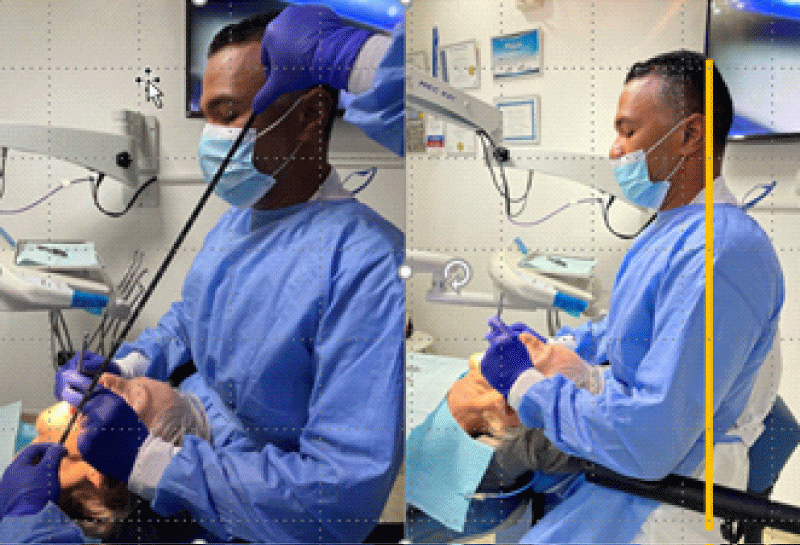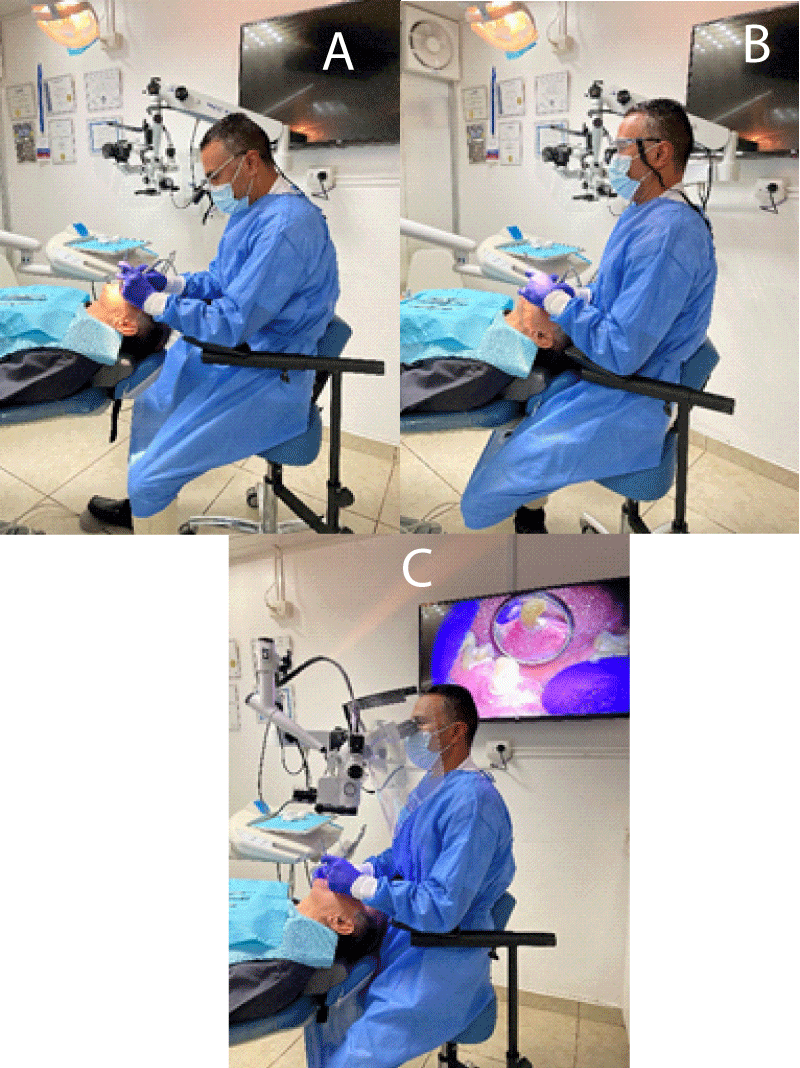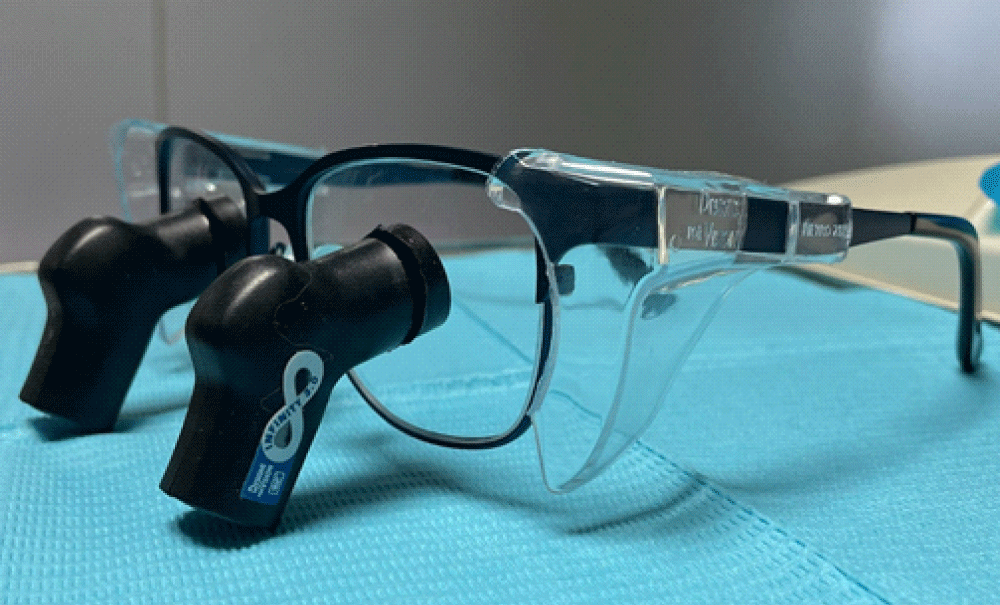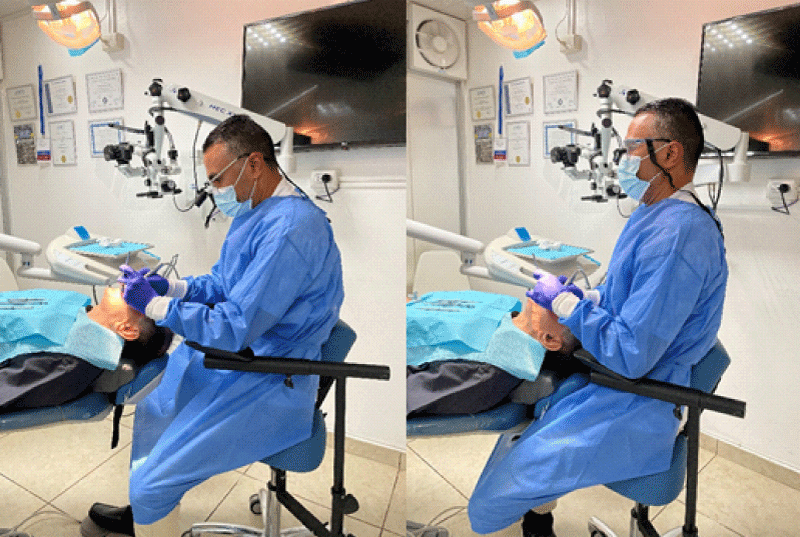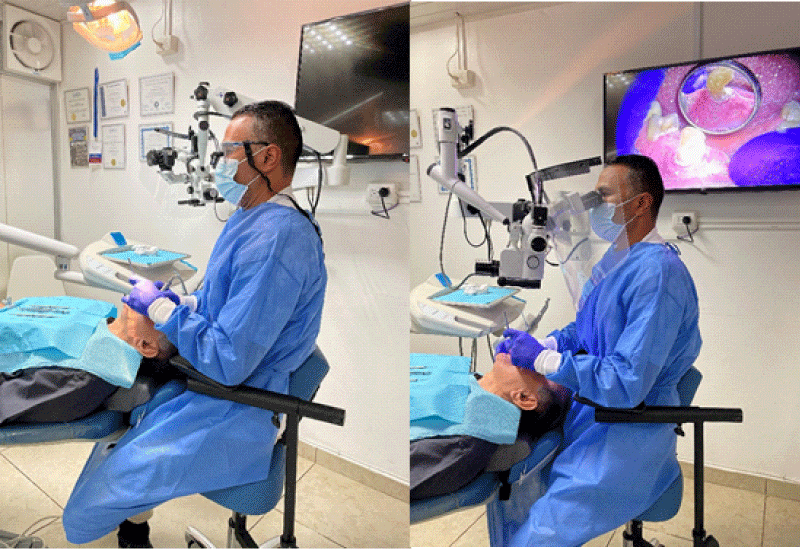More Information
Submitted: July 31, 2023 | Approved: August 16, 2023 | Published: August 17, 2023
How to cite this article: Hugues JCO. High Magnification in Dentistry; Postural Benefits using Magnification Loupes to Improve Dental Work Performance. J Clin Adv Dent. 2023; 7: 013-017.
DOI: 10.29328/journal.jcad.1001035
Copyright License: © 2023 Hugues JCO. This is an open access article distributed under the Creative Commons Attribution License, which permits unrestricted use, distribution, and reproduction in any medium, provided the original work is properly cited.
Keywords: Ergonomics; Magnification loupes; Posture
High Magnification in Dentistry; Postural Benefits using Magnification Loupes to Improve Dental Work Performance
Juan Carlos Ortiz Hugues*
Academy of Microscope Enhanced Dentistry (AMED), USA
*Address for Correspondence: Juan Carlos Ortiz Hugues, Academy of Microscope Enhanced Dentistry (AMED), USA, Email: [email protected]
Stress, pain, injuries, and errors in dental procedures are situations highly linked to dentistry derived from multiple factors making this profession a profession with high physical and mental demand to achieve quality treatment without deteriorating the health of those who perform it, in this case, the dentist, the assistant, and hygienist.
The effects of wrong postures, but above all, the lack of knowledge of the proper postures, the modeling of bad habits acquired during the training stage in dental school, and the lack of work guidelines that not only take into account the dentist but also to all the work staff and the methodological organization of dental tasks can be found in the scientific literature.
Magnification devices are known to improve vision, precision, and ergonomics in dentistry; advances in the area of high magnification in dentistry are taking place by leaps and bounds. In recent years, a new magnification loupes design has appeared on the market, called ergonomic magnification loupes appeared that stands out from conventional Galilean and Keplerian through the lens (TTL) Flip-up loupes in terms of their postural benefits and is part of the arsenal of magnification loupes to consider in the market.
The postural approach of high magnification equipment is necessary for professional practice, where the design of Ergonomic magnification loupes with consideration not only for magnification but also for the operator’s postural health which can have a significant impact on the performance and overall health of the dentist and hygienist, more if incorporated from the beginning of dental school education and training.
In the Ergonomic magnification loupes, the arrangement of the prisms’ Keplerian design is modified so the optical pathway is curved 45 degrees producing the deflection of the image so that the operator can work with the head in a neutral position, reducing the cervical angle from 20° of forward head flexion to 0° [1] (Figure 1).
Figure 1: Neutral Seated Posture with ergonomic magnification loupes.
The already proven advantages of dental work with the use of magnification loupes in terms of treatment quality, posture, and performance, are only sustained through proper training and proper selection of loupes from the start by customizing working distance and interpupillary distance [2-4].
The inappropriate selection and use of magnification loupes can impair the sense of position, orientation, and movement of the head and neck, resulting in the aggravation of musculoskeletal symptoms and eyestrain [5].
A key aspect to consider with any newly acquired technology is the training [6,7], and it should address the learning of biomechanics of the human body applied with magnification loupes physical principles such as depth of focus and field of view, which allow professionals to make the correct adjustments, according to the procedure performed [8].
Among the ergonomic considerations for magnification loupes selection, customizing the interpupillary distance and working distance will ensure maintaining the correct ergonomic posture and focal distance, promoting better use of the loupes [9].
The interpupillary distance is the distance between the center of the pupils, and the working distance is the distance between your eyes and the patient’s teeth while maintaining an ergonomic position, and is reliable information on the acquisition of the magnification loupes [10].
Proper selection of the working distance is vital for the operator to preserve the posture during the dental work. Figures 2,3 Any forward movement toward the patient’s mouth will interrupt the clarity of the image focus by altering the focal distance set on the optics.
Figure 2: Measurement of the working distance.
Figure 3: A. Through-the-lens Galilean magnifying glasses, without prior measure-ment of working distance, unhealthy posture, non-neutral head and back. B. Ergonomic magnification loupes with interpupillary and distance adjustment prior to work, neutral working posture. C. Dental microscope , neutral working posture.
Another no less important factor that affects the operator’s posture is the magnification power, the improvement in working posture resulting from the use of magnification systems may be explained by the improved visualization of the operating field, also a statistically significant increase in visual acuity is achieved by increasing the magnification [11,12].
The selection of the type of magnification power depending on user experience, the specialty, and the needs of the depth of field, the field of view, and the need for greater or lesser magnification will be significant for the degree of information necessary when working in the different specialties, in turn with the comfort in its use [13].
Proper lighting, in addition to the power of magnification, is critical in highly demanding eye-hand coordination and tactile perception required in dentistry, calling for the highest visual function, stereo vision, and object depth perception [14,15].
Although the conventional magnification loupes systems have reduced the angular deviation of the neck, it remains higher than what is considered neutral, more than all due to the declination angle and weight [16-18].
Using conventional or ergonomic magnification loupes following established neutral seated work posture guidelines, postural awareness, and adequate use of indirect vision with the mirror can lead the operator to optimal use of them while improving working efficiency and the operator´s health [19].
The neutral seated posture during dental work protects our body by placing minimal loads on the cervical, lumbar, shoulders, and arms. Following the recommended side view, angulation is the starting point to deliver stress-free practice in the body [20]:
Head posture: eyes 0 - 20° downward, aligned with shoulders; shoulders aligned with hips; hips 110 - 125 °angulation.
The dentist positioning at 12 o’clock and the positioning of the patient in a horizontal position in the dental chair with the mouth at the height of the operator’s elbows will create postural symmetry for the operator and strategic vision angles to work in both maxillary without displacing the body out of the neutral position minimizing the fatigue [21].
By being systematic in the positioning, the operator will help use the magnification loupes more efficiently, optimized by working four-handed-dentistry with the assistant [22].
In the literature, when compared, the optical advantages offered by different magnification devices, such as the conventional magnification loupes, ergonomic magnification loupes, and dental microscopes, provide advantages and disadvantages. The dental microscope is highly superior visually and ergonomically and is indispensable for visual control, making the dental microscope the visual and postural gold standard for the operator [23].
The microscope offers multiple magnification steps and coaxial light, depth of field, keeping an upright position, and the ability to quickly generate complete operative information promoting better precision due to the high magnification power, not only in endodontics [24-26].
The principal ergonomic problem with the magnification loupes among dentists is the lack of fixed position (fine movements of the dentist’s head disturb the image of the magnified operating field) and the need to change the loupes to achieve different magnifications compared to the dental microscopes [27].
However, the most significant disadvantage of the dental microscope is the high initial investment cost and the more complex and often lengthy learning curve, even more without adequate training in its use [28]. The ergonomic magnification loupes can represent a significantly cheaper portable alternative, with the postural benefits for the operator and also a potential leap to jump to a higher magnification with all the benefits of the dental microscope with time [29-31] (Figures 4-6) (Table 1).
Figure 4: Ergonomic Magnification Loupes.
Figure 5: Postural Comparison between a non-customed conventional loupes selection vs. customed ergonomic magnification loupes.
Figure 6: Postural Comparison between a customed ergonomic magnification loupes and the dental microscope, both promoting neutral body posture.
| Table 1: Dental Microscope vs. Magnification Loupes. | |
| Dental Microscope vs. Loupes | |
| Advantages of Dental Microscope vs. Magnification Loupes | Advantages of Magnification Loupes vs. Dental Microscope |
| • Stereoscopic View, no eye convergence • 5 to 6, magnification steps • Image stability • No weight in nose and head • Live documentation • Less eye strain and fatigue to the operator • Co-Axial Lighting without shadows • Promote Neutral body posture |
• Portable, small in size, easy to use and store • No formal training required • Operator Position not restricted • Price • Minimal Maintainance |
According to the information collected, to guarantee the proper selection and use of magnification loupes, the operator considers the following guidelines:
- The representative must have the correct information about the operator’s interpupillary distance before purchasing the loupes, becoming the most important selection factor of the magnification loupes system.
- The operator must measure the working distance based on their neutral seated posture and with a patient in the correct position in the dental chair to ensure the best posture when working according to individual measurements.
- Operator placed in neutral posture, head posture, ears aligned with the shoulder in lateral view
- Operator at 12 o clock behind the patient’s head
- The operator should get close to the headrest of the dental chair
- Patient at the end of the headrest of the dental chair in a horizontal position
- Patient head at the top of the headrest
- The frame of the loupes should rest nicely on the base of the nose for more image stability
- The position of the patient, mouth at the level of the operator’s elbows or slightly higher, guarantees the operator’s posture and the focal clarity of the loupes during the dental work.
- Indirect vision and mirror skills, plus movements of the patient’s head, promote workflow during the procedure without attempting the neutral posture [32,33].
- Four-handed dentistry with the assistant will help the operator to maintain a neutral posture and regulate unnecessary movements during the procedure with the magnification loupes [34].
- Due to adjusting the working distance previously set in the loupes, the operator is forced positively to work in a neutral position to see the work surfaces clearly.
The main objective of this article is to guide the dental professional about the importance of adequate high magnification tools, taking into account the personalized information for the selection of loupes, referring to the virtues of ergonomic loupes and the postural, workflow, and performance benefits in the dental tasks with simple guidelines.
The information in this article has provided insight into the need for magnification in dentistry and the postural factor in the use of available technologies with recommendations for the proper selection and proper use, which are necessary to enhance the benefits they offer.
The leap in quality, thanks to technological advances from conventional loupes with declination angles to ergonomic magnification loupes aimed at improving the operator’s posture, is a qualitative leap that places these ergonomic loupes on a similar postural plane for the operator as the microscope.
The key is whether their use is carried out under a systematized approach centralized in the user, complying with guidelines, training, and use that consider the posture, movements, and the position of the operator, the position of the patient in the dental chair, and the training suitable of the assistant; factors that will optimize the ergonomic use and influence the health and efficient work of the operator and the staff.
High magnification in dentistry is necessary, but in the same way technology without training and without considering the user can lead to inappropriate use of them, which makes them irrelevant, poorly usable, or misused.
- Lindegård A, Gustafsson M, Hansson GÅ. Effects of prismatic glasses including optometric correction on head and neck kinematics, perceived exertion and comfort during dental work in the oral cavity--a randomised controlled intervention. Appl Ergon. 2012 Jan;43(1):246-53. doi: 10.1016/j.apergo.2011.05.011. PMID: 21664603.
- Maggio MP, Villegas H, Blatz MB. The effect of magnification loupes on the performance of preclinical dental students. Quintessence Int. 2011 Jan;42(1):45-55. PMID: 21206933.
- Mallikarjun S, Devi P, Naik A, Tiwari S. Magnification in dental practice: how useful is it? J Health Res Rev. 2015; 2:39-44.
- Low JF, Dom TNM, Baharin SA. Magnification in endodontics: A review of its application and acceptance among dental practitioners. Eur J Dent. 2018 Oct-Dec;12(4):610-616. doi: 10.4103/ejd.ejd_248_18. PMID: 30369811; PMCID: PMC6178675.
- Hayes MJ, Osmotherly PG, Taylor JA, Smith DR, Ho A. The effect of wearing loupes on upper extremity musculoskeletal disorders among dental hygienists. Int J Dent Hyg. 2014 Aug;12(3):174-9. doi: 10.1111/idh.12048. Epub 2013 Jul 26. PMID: 23890467.
- Narula K, Kundabala M, Shetty N, Shenoy R. Evaluation of tooth preparations for Class II cavities using magnification loupes among dental interns and final year BDS students in preclinical laboratory. J Conserv Dent. 2015 Jul-Aug;18(4):284-7. doi: 10.4103/0972-0707.159724. PMID: 26180411; PMCID: PMC4502122.
- Mallikarjun SA, Devi PR, Naik AR, Tiwari S. Magnification in dental practice: how useful is it? Journal of Health Research and Reviews. 2015; 2(2):39-44. doi 10.4103/2394-2010.160903.
- Resende CA, Almeida JFA, Campos PEGA, Souza-Filho FJ, Dekon SFC. The application of clinical microscope in dentistry. Rev Odontol Araçatuba. 2008; 29(1):9-12.
- Chang BJ. Ergonomic benefits of surgical telescope systems: selection guidelines. J Calif Dent Assoc. 2002 Feb;30(2):161-9. PMID: 11881960.
- Valachi B. Magnification in dentistry: how ergonomic features impact your health. Dent Today. 2009 Apr;28(4):132, 134, 136-7. PMID: 19408593.
- James T, Gilmour AS. Magnifying loupes in modern dental practice: an update. Dent Update. 2010 Nov;37(9):633-6. doi: 10.12968/denu.2010.37.9.633. PMID: 21179934.
- Urlic I, Pavan J, Verzak Z, Karlovic Z, Negovetic Vranic D. The Best Dentistry Professional Visual Acuity Measured under Simulated Clinical Conditions Provides Keplerian Magnification Loupe: A Cross-Sectional Study. Dent J (Basel). 2021 Jun 11;9(6):69. doi: 10.3390/dj9060069. PMID: 34208048; PMCID: PMC8230659.
- Carpentier M, Aubeux D, Armengol V, Pérez F, Prud'homme T, Gaudin A. The Effect of Magnification Loupes on Spontaneous Posture Change of Dental Students During Preclinical Restorative Training. J Dent Educ. 2019 Apr;83(4):407-415. doi: 10.21815/JDE.019.044. Epub 2019 Feb 11. PMID: 30745350.
- Aldosari MA. Dental Magnification Loupes: An Update of the Evidence. J Contemp Dent Pract. 2021 Mar 1;22(3):310-315. PMID: 34210934.
- Syrimi M, Ali N. The role of stereopsis (three-dimensional vision) in dentistry: review of the current literature. Br Dent J. 2015 May 22;218(10):597-8. doi: 10.1038/sj.bdj.2015.387. PMID: 25998354.
- Congdon LM, Tolle SL, Darby M. Magnification loupes in U.S. entry-level dental hygiene programs--occupational health and safety. J Dent Hyg. 2012 Summer;86(3):215-22. Epub 2012 Aug 27. PMID: 22947844.
- Mamoun J, Wilkinson ME. Technical Aspects and Clinical Usage of Keplerian and Galilean Binocular Surgical Loupe Telescopes Used in Dentistry or Medicine. 2013; 142-49.
- Rucker LM, Beattie C, McGregor C, Sunell S, Ito Y. Declination angle and its role in selecting surgical telescopes. J Am Dent Assoc. 1999 Jul;130(7):1096-100. doi: 10.14219/jada.archive.1999.0343. PMID: 10422406.
- Mamoun JS. Surgical and Dental Ergonomic Loupes -- Magnification and Microscope Design Principles -- Technical Aspects and Clinical Usage of Keplerian and Galilean Binocular Surgical Loupe Telescopes used in Dentistry or Medicine. 2013.
- Galla A, Chowdhry A, Bagga A, Moradia L, Tadikonda A, Pentapati K, Mysore NK. Dental practitioners' knowledge, attitudes, and practices of ergonomics - a cross-sectional web-based survey. Acta Biomed. 2022 May 12;93(S2):e2022048. doi: 10.23750/abm.v93iS2.12908. PMID: 35545983; PMCID: PMC9534214.
- Hokwerda O. Symposium: Ergonomic principles for patient treatment. Syllabus paper. 2004
- Hokwerda O, Wouter JAJ. Ergonomic requirements for dental equipement. ESDE. 2007.
- Dalai. Four-Handed Dentistry: An Indispensable Part for Efficient Clinical Practice. Int J Adv Health Sci. 2014; 1.
- Perrin P, Eichenberger M, Neuhaus KW, Lussi A. Visual acuity and magnification devices in dentistry. Swiss Dent J. 2016;126(3):222-235. English, German. PMID: 27023468.
- Pispero A, Marcon M, Ghezzi C, Massironi D, Varoni EM, Tubaro S, Lodi G. Posture Assessment in Dentistry for Different Visual Aids Using 2D Markers. Sensors (Basel). 2021 Nov 19;21(22):7717. doi: 10.3390/s21227717. PMID: 34833788; PMCID: PMC8619426.
- Bud M, Jitaru S, Lucaciu O, Korkut B, Dumitrascu-Timis L, Ionescu C, Cimpean S, Delean A. The advantages of the dental operative microscope in restorative dentistry. Med Pharm Rep. 2021 Jan;94(1):22-27. doi: 10.15386/mpr-1662. Epub 2021 Jan 29. PMID: 33629044; PMCID: PMC7880065.
- Atlas AM, Janyavula S, Elsabee R, Alper E, Isleem WF, Bergler M, Setzer FC. Comparison of loupes versus microscope-enhanced CAD-CAM crown preparations: A microcomputed tomography analysis of marginal gaps. J Prosthet Dent. 2022 May 25:S0022-3913(22)00225-6. doi: 10.1016/j.prosdent.2022.04.008. Epub ahead of print. PMID: 35643825.
- Das UK. Dental Operating Microscope in Endodontics-A Review. IOSR J Dental Med Sci (IOSR-JDMS). 5: 2013.
- Doppalapudi N, Burugapalli RK. Benefits of Utilization of Magnification in Dentistry: A Review. Dent Res Oral Health. 2020; 3: 121-128.
- Alhazzazi TY, Alzebiani NA, Alotaibi SK. Awareness and attitude toward using dental magnification among dental students and residents at King Abdulaziz University, Faculty of Dentistry. BMC Oral Health. 2017; 17(1):21. doi: 10.1186/s12903-016-0254-4
- Meraner M, Nase JB. Magnification in dental practice and education: experience and attitudes of a dental school faculty. J Dent Educ. 2008 Jun;72(6):698-706. PMID: 18519600.
- Garcia PPNS, Pugliesi PMS, Wajngarten D, Neves TDC, Pazos JM, Dovigo LN. Development and assessment of an indirect vision training programme for operatory dentistry: Effects on working posture. Eur J Dent Educ. 2022 Feb;26(1):36-44. doi: 10.1111/eje.12670. Epub 2021 Mar 18. PMID: 33527639.
- Jeong YJ, Choi JS. The effect of indirect vision skills on head and shoulder posture amongst Korean dental hygienists. Eur J Dent Educ. 2020 Feb;24(1):17-25. doi: 10.1111/eje.12463. Epub 2019 Sep 29. PMID: 31518468.
- Finkbeiner BL. Four-handed dentistry revisited. J Contemp Dent Pract. 2000 Nov 15;1(4):74-86. PMID: 12167952.
